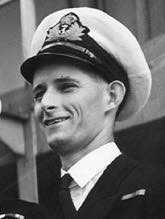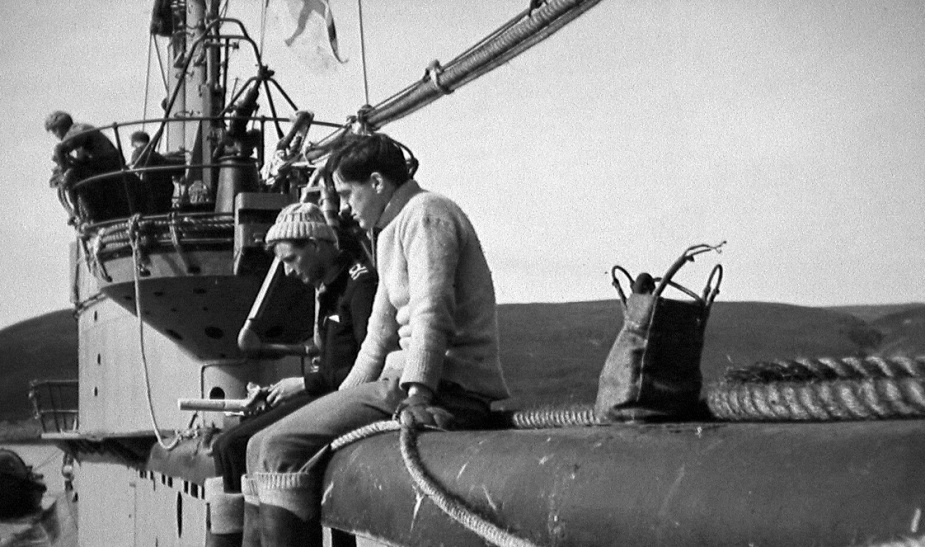Lieutenant Commander Maxwell Henry Shean

Maxwell ‘Max’ Henry Shean was born in Perth on 6 July 1918, the son of Henry Shean, an under-secretary for law with the Western Australian public service, and his wife, Gladys Shean (nee Bailey). Max was a keen yachtsman and educated at Perth Technical College. In 1937, he commenced a degree in mechanical and electrical engineering at the University of Western Australia.
In mid-1940, following the evacuation of Dunkirk, Max Shean volunteered for service in the RAN Volunteer Reserve (RANVR) and was mobilised on 26 October 1940 at HMAS Leeuwin, Western Australia as a probationary Sub Lieutenant. He served briefly at Leeuwin, and HMAS Cerberus, before commencing an anti-submarine warfare course at HMAS Rushcutter in early December 1940. His training also included service in HMAS Kybra where he learnt seamanship, navigation, watchkeeping, small boat handling, fire-fighting and damage control. He completed his training in April 1941 and soon after proceeded to the United Kingdom, in the MV Coptic via the Panama Canal, for further training and loan service with the Royal Navy.
After arriving in the United Kingdom he joined the Flower Class corvette HMS Bluebell on 7 July 1941. He was to serve in her as an Anti-Submarine Warfare Officer for the next 14 months. Bluebell was part of the 37th Escort Group escorting convoys between Britain and Gibraltar, and Shean took part in some of the bitterest fighting of the Battle of the Atlantic. His skill and proficiency in using his ASDIC (sonar) earned him the nickname ‘Ping King’ on board Bluebell.
At the end of 1941 Bluebell took part in the desperate defence of convoy OG77, which was attacked by a German U-Boat wolf pack while off Cape St Vincent. On the night of December 11/12 Shean heard the high-pitched whine of torpedoes three times through his headset and warned his captain in time to have Bluebell alter course to avoid the approaching weapons. Bluebell also dropped two patterns of depth charges during the night and may have contributed to the sinking of U-208, although both British and German records are inconclusive.
While Bluebell was in refit, at Newcastle-on-Tyne, in mid-1942 an Admiralty Fleet Order called for volunteers for ‘special and hazardous service, who are: below age 24, unmarried, good swimmers and of strong and enduring physique’. Shean volunteered without knowing what he was actually volunteering for. On 14 August 1942 he joined the submarine training depot HMS Dolphin, at Gosport, to undergo initial training as a diver for service in midget submarines known as X-Craft.
Shean was accepted for further training and sent to HMS Varbel, a shore depot on the Isle of Bute in north west Scotland. The X-Craft were 27 ton midget submarines that were 16 metres in length and operated by a four-man crew. They had been designed to attack German shipping, particularly warships operating from Norwegian fjords, which had anti-torpedo and anti-submarine nets surrounding the anchored vessels and heavy anti-aircraft defences. Their weapon carried as ‘side cargo’ were high explosive charges designed to be jettisoned underneath enemy warships with fuses set for some hours later. The resultant explosion would cause significant overpressure designed to rupture the ship’s hull and sink or disable it.
As an X-Craft diver, Shean had to practise getting into and out of the submerged submarine through a small wet-and-dry chamber, shutting himself off from the rest of the crew before flooding the compartment and opening the external hatch. He also practised cutting underwater nets in Scottish lochs, which were always cold and black. There were accidents and deaths during training, but Shean always felt sure that they could beat the odds. Max Shean was promoted to Lieutenant on 23 April 1943.
His first mission was Operation SOURCE, the attack by a flotilla of five X-craft on the German battleship Tirpitz and the battlecruiser Scharnhorst, in Kafjord in northern Norway, during 20-22 September 1943. A sixth X-Craft was directed to attack the heavy cruiser Lutzow in Langfjord. The X-Craft were manned by passage crews and towed there by parent submarines, while the attack crews, including Shean, prepared themselves in the towing vessels.
Disaster struck, however, when Shean's X-9, being towed by HMS Syrtis, broke her tow and sank. The tow-rope became tangled round Syrtis's port propeller, and Shean, whose diving suit was in X-9, plunged over the side into the freezing waters. Wearing overalls weighted with steel bars in the pockets, Shean repeatedly duck-dived until he could free the tangled tow line. Knowing that if Syrtis was spotted by patrolling German forces she would dive, and abandon him on the surface, Shean was more frightened than he had ever been; and when he was hauled on board, the submarine's Commanding Officer rewarded him with a simple “Well done!”
X-8 failed in her attempt to attack Lutzow when she began to take on water and her demolition charges were ditched, but exploded prematurely damaging the vessel and forcing her to be scuttled. X-10 commanded by Lieutenant Ken Hudspeth, RANVR suffered mechanical failure and withdrew from Kafjord without laying her charges. X-5 was attacked and sunk by German naval forces within the fjord. X-6 and X-7 laid their charges but were then spotted by German forces and sunk; six of the eight crew survived to become prisoners of war. Tirpitz was badly damaged when the demolition charges exploded and was out of action until April 1944. She was eventually destroyed by heavy bombing by Lancaster bombers in November 1944.
Shean returned to Varbel and continued training for further operations against German shipping. One of the lessons from Operation SOURCE was the potential for confusion during multiple attacks, so in Operation GUIDANCE during mid-April 1944, Shean, now in command of X-24, was towed by the submarine HMS Sceptre to Bergen, Norway, to make a solo attack on a large floating dock.
X-24 successfully penetrated the fjords to reach the harbour, but inadequate intelligence caused him to lay the explosive charges under the 7800-ton German merchant ship Barenfels, instead of the floating dock. Barenfels was sunk in the resultant explosion while the floating dock was undamaged - despite this it was a model attack, and 24 hours later, sick and suffering from headaches caused by the stale air in the boat, Shean and his crew rendezvoused at sea with Sceptre. Lieutenant Shean was awarded a Distinguished Service Order (DSO) ‘for great courage, skill and determination in a most hazardous enterprise’ (London Gazette, 13 June 1944). In June 1944 Shean married Mary Golding who he had first met in 1942. They later had two daughters.
On 15 November 1944, Shean was appointed in command of XE-4 then nearing the end of her construction at Vickers Pty Ltd, Barrow-in-Furness. Mary Shean christened the submarine, on 4 December 1944, with a bottle of Australian champagne broken across her bow and giving her the unofficial name Exciter. On 7 December 1944 Shean joined the submarine depot ship HMS Bonaventure which by then had XE-1 - XE-6 loaded on board.
Bonaventure departed Scotland in early 1945 and sailed across the Atlantic, transited the Panama Canal and after a stopover on the US west coast and Pearl Harbor arrived in Australia in May 1945. Training commenced in Queensland waters and in June Bonaventure sailed north to Subic Bay, in the recently liberated Philippines, to commence X-Craft operations. On 25 July 1945 Bonaventure arrived at Brunei Bay on the north coast of Borneo. From there the X-Craft sailed on various missions
XE-4 was directed to conduct Operation SABRE; the cutting of two underwater telegraph cables off Japanese-occupied Saigon. The Japanese were using the telegraph cables to send messages and these could not be intercepted by the Allies. By cutting the cables the Japanese would be forced to use wireless communications which could be intercepted and decoded by the Allies. Shean designed new grapnels to hook the undersea cables, which Engine Room Artificer Vernon ‘Ginger’ Coles manufactured. On 27 July the submarine HMS Spearhead took XE-4 in tow for the three day transit across the South China Sea.
On the morning of 30 July Shean took over XE-4 from the transit crew and using underwater dead reckoning, updated by occasional sightings of the Cap St Jacques lighthouse, Shean navigated XE-4 into the shallow mouth of the Mekong river where, on 31 July 1945, he began a submarine trawl for the cables. After ploughing the seabed for hours, XE-4 snagged the first cable, and 13 minutes later the diver, fellow Australian Sub Lieutenant Ken Briggs, RANVR returned on board with a short length of cable as proof that it had been cut. Resuming the trawl the second cable was located, much deeper than the first, and Sub Lieutenant Adam Bergius, RNVR cut this cable after several attempts.
Shortly after midnight XE-4 rendezvoused with Spearhead and was towed to Subic Bay. Shean was subsequently awarded a Bar to his DSO ‘for gallantry, perseverance and outstanding skill in successfully cutting the Hong Kong-Saigon and Singapore-Saigon cables on 31st July 1945. The operation was performed in water much deeper than expected and hampered by tide and rough weather’ (London Gazette, 18 December 1945). Briggs and Bergius were each awarded a Distinguished Service Cross and Coles a mention in dispatches to go with his Distinguished Service Medal for the Bergen attack. Shean was later awarded the US Bronze Star for ‘devotion to the accomplishment of a daring mission that contributed essentially to the success of Allied operations in the Pacific War’.
Lieutenant Shean returned to Australia in early September 1945 and was discharged from the RANVR at Leeuwin on 15 September 1945. After the war Shean completed his engineering degree and worked for the City of Perth Electricity and Gas Department, and the State Electricity Commission until his retirement in 1978. Shean also joined the RAN Reserve on 18 November 1949 as a Lieutenant (engineer) and served at HMAS Leeuwin. He also conducted regular periods of training in HMA Ships Australia, Sydney and Vengeance and was promoted to Lieutenant Commander (engineer) on 30 June 1955. Shean resigned from RAN Reserve on 31 December 1955.
In 1979 he celebrated the 150th anniversary of the settlement of Western Australia by sailing to Plymouth in his yacht Bluebell. He then competed in the open division of the Parmelia Yacht Race from Plymouth to Fremantle, via Capetown, winning the race. His wartime autobiography 'Corvette and Submarine' was published in 1992 and in May 2005 Shean and his wife traveled to Europe to take part in the Department of Veterans' Affairs VE-Day 60th anniversary activities.
Max Shean died on 15 June 2009 in Perth, WA and was farewelled with a full service funeral at Karrakatta Cemetery. He was survived by his wife Mary and their two daughters.




